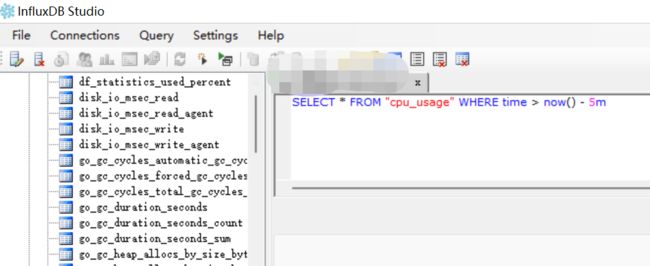influxdb常用命令、influxdb增删改查、SpringBoot整合influxdb
influxdb常用命令、influxdb增删改查、SpringBoot整合influxdb
- 一、influxdb一些概念
-
- 1、时序数据库
- 2、influxdb和mysql类比
- 3、points(类似表的一行数据)数据结构
- 4、measurement特性
- 5、Tag和Field
- 6、Series
- 二、数据库、表操作命令
- 三、influxdb的sql操作
-
- 1、select
- 2、where语句
- 四、SpringBoot整合influxdb
- 五、influxdb图形化界面客户端
一、influxdb一些概念
Influxdb是一个开源的分布式时序、时间和指标数据库,使用go语言编写,无需外部依赖。 注意:
influxdb只针对单机版开源,集群版还是要收费的。
1、时序数据库
什么是时间序列数据库,最简单的定义就是数据格式里包含Timestamp字段的数据,比如某一时间环境的温度,CPU、内存的使用率等。
influxdb常用来存储一些性能数据,比如cpu使用率,网络的流入、流出速率。根据性能数据就可以监控设备的状态,监控系统中常用influxdb。
2、influxdb和mysql类比
3、points(类似表的一行数据)数据结构
4、measurement特性
- measurement无需单独创建,在第一次插入数据时自动创建。
- measurement中无数据,表也就不存在了。
- measurement没有update语句,无法修改measurement以及tags-key和fields-key名称,实际中如有需要只能删除整个measurement重新插入数据。不过也可以通过select * into newxxx from oldxxx,从旧表中查出数据导入到新表。
5、Tag和Field
Tag
- 相当于mysql的索引
- Group查询时只能用tag字段
Field
- 函数操作只能用Field字段,例如sum()
- 查询时只能使用Field进行比较操作
- 如果需要使用int,float,boolean类型进行存储,只能使用Field
讲白了,当我们存机器的cpu使用率时,主机的IP,Name等信息用Tag存,而使用率则用Field存。
6、Series
InfluxDB中的series是一种集合的概念,在同一个database中,相同retention policy、相同measurement、相同tag的数据属于一个series集合,同一个series的数据在物理上按照时间顺序排列在一起。
series就是不同tag列,进行排列组合。比如一个表中有两个tag字段A和B。 A字段有有3种值,B字段有4种值,则series个数 = 3*4=12个。
二、数据库、表操作命令
1、数据库操作
//查看所有数据库
show databases
//进入到某个数据库
use influxdb
//查看用户,两列数据,一列是用户名称,一列是是否为管理员用户
show users
//创建普通户
create user "influx" with password '123456'
//创建管理员用户
create user "root" with password '123456' with all privileges
//修改用户密码
set password for root= 'root'
//通过cli操作influxdb
influx -username root -password root
/**
* 数据库设置admin权限的两种方式(建议使用第二种)
*/
GRANT ALL PRIVILEGES ON 数据库名称 TO 用户名称
GRANT ALL PRIVILEGES TO 用户名称
/**
* 数据库撤销admin权限的两种方式(建议使用第二种)
*/
Revoke ALL PRIVILEGES ON 数据库名称 FROM 用户名称
Revoke ALL PRIVILEGES FROM 用户名称
//查看所有表
show measurements
//查看表的tag
show tag keys from 表名称
//查看表的field
show field keys from 表名称
//查看表的series
show series from "表名称"
//查看当前库的series
show series
//查看数据保存策略(建议使用第二种)
show retention policies on "数据库名称"
show retention policies
/**
* 创建数据保留策略
* h(小时),d(天),w(星期)
*/
//CREATE RETENTION POLICY "保留策略名称" ON "数据库名称" DURATION "该保留策略对应的数据过期时间" REPLICATION "复制因子,开源的InfluxDB单机环境永远为1" SHARD DURATION "分片组的默认时长" DEFAULT
create retention policy "testPolice" on myInfluxdb duration 72h replication 1 SHARD DURATION 1h default
//修改保留策略
alter retention policy "保留策略名称" on "数据库名称" duration 1d
//删除保留策略
drop retention policy "保留策略名称" on "数据库名称"
2、表(插入)操作
一般情况下,经常作为查询条件的列,在初始时设置为tag,即索引,fields不常作为查询条件,更甚者,在复杂查询语法中,聚合语句group by 后面只能是time和tags
/**
* InfluxDB中没有显式的新建表的语句,只能通过insert数据的方式来建立新表。
* 其中 cpu_virtual_used_num就是表名,host,hostname索引(tag),value=xx是记录值(field),记录值可以有多个,后面的时间戳是我们指定的,如果不指定系统自动加当前时间时间戳。
*/
insert cpu_virtual_used_num,host=470b14f0-e869-43ed-a8e6-fd634258271f,hostname=server01 value=0.96516
//删除表
drop measurement cpu_virtual_used_num
//删除数据
//influxDB是没有提供直接删除数据记录的方法,但是提供数据保存策略,主要用于指定数据保留时间,超过指定时间,就删除这部分数据。(数据库过期策略至少一个小时)
三、influxdb的sql操作
1、select
查询注意:
1、如果measurement、tag、field等的标识符除了[A-z,0-9,_]之外,还有其他字符,或者标识符是keyword关键字,那么在引用的时候必须加上双引号。比如在表 h2o_feet 中,"level description"就是一个带有空格的field,如此一来在查询到的时候,就必须加上双引号了。在查询level description时若不加双引号,则会报错。
2、在SELECT 子句中,必须要有至少一个field key!如果在SELECT子句中只有一个或多个tag key,那么该查询会返回空。这是由InfluxDB底层存储数据的方式所导致的结果。
2、where语句
注意事项:
1、在WHERE子句中,支持在fields, tags, and timestamps上进行条件表达式的运算。
2、在InfluxDB的WHERE子句中,不支持使用 OR 来指定不同的time区间,否则将为空。
3、在WHERE子句中,支持对string, boolean, float 和 integer类型的field values进行比较。
4、在WHERE子句中,如果是string类型的field value,一定要用单引号括起来。如果不适用引号括起来,或者使用的是双引号,将不会返回任何数据,有时甚至都不报错!
5、对于在WHERE子句中的tag values,也要用单引号括起来。如果不用引号括起来,或者使用双引号,则查询不会返回任务数据。甚至不会报错。
四、SpringBoot整合influxdb
1、引入maven
<!-- 引入influxdb-->
<dependency>
<groupId>org.influxdb</groupId>
<artifactId>influxdb-java</artifactId>
</dependency>
2、application.yml
server:
port: 8080
spring:
influx:
url: http://127.0.0.1:8086 #influxdb服务器的地址
username: #用户名
password: #密码
database: rightcloud #指定的数据库
retention_policy: autogen
3、InfluxdbConfig配置类
import org.influxdb.InfluxDB;
import org.influxdb.InfluxDBFactory;
import org.springframework.beans.factory.annotation.Value;
import org.springframework.context.annotation.Bean;
import org.springframework.context.annotation.Configuration;
import org.springframework.util.StringUtils;
/**
* influxdb配置文件
*/
@Configuration
public class InfluxdbConfig {
@Value("${spring.influx.url}")
private String influxDBUrl;
@Value("${spring.influx.username}")
private String userName;
@Value("${spring.influx.password}")
private String password;
@Value("${spring.influx.retention_policy}")
private String retention_policy;
@Value("${spring.influx.database}")
private String database;
@Bean
public InfluxDB influxdb() {
InfluxDB influxDB = null;
if (StringUtils.isEmpty(userName)) {
influxDB = InfluxDBFactory.connect(influxDBUrl);
} else {
influxDB = InfluxDBFactory.connect(influxDBUrl, userName, password);
}
try {
/**
* 异步插入:
* enableBatch这里第一个是point的个数,第二个是时间,单位毫秒
* point的个数和时间是联合使用的,如果满100条或者60 * 1000毫秒
* 满足任何一个条件就会发送一次写的请求。
*/
// influxDB.setDatabase(database).enableBatch(100, 1000 * 60, TimeUnit.MILLISECONDS);
influxDB.setDatabase(database);
} catch (Exception e) {
e.printStackTrace();
} finally {
//设置默认策略
this.retention_policy = retention_policy == null || "".equals(retention_policy) ? "autogen" : retention_policy;
influxDB.setRetentionPolicy(retention_policy);
}
//设置日志输出级别
influxDB.setLogLevel(InfluxDB.LogLevel.BASIC);
return influxDB;
}
}
4、InfluxDBUtils工具类,提供增删改查方法
import org.influxdb.InfluxDB;
import org.influxdb.annotation.Column;
import org.influxdb.annotation.Measurement;
import org.influxdb.dto.BatchPoints;
import org.influxdb.dto.Point;
import org.influxdb.dto.Query;
import org.influxdb.dto.QueryResult;
import org.springframework.beans.factory.annotation.Autowired;
import org.springframework.beans.factory.annotation.Value;
import org.springframework.stereotype.Component;
import java.lang.reflect.Field;
import java.util.ArrayList;
import java.util.HashMap;
import java.util.List;
import java.util.Map;
import java.util.concurrent.TimeUnit;
/**
*
*/
@Component
public class InfluxDBUtils {
@Autowired
private InfluxDB influxDB;
@Value("${spring.influx.database}")
private String database;
/**
* 插入单条数据写法1
*
* @param measurement
*/
public void insertOne01(String measurement) {
//构建
Point.Builder builder = Point.measurement(measurement);
//可指定时间戳
builder.time(System.currentTimeMillis(), TimeUnit.MILLISECONDS);
//tag属性只能存储String类型
builder.tag("name", "zhanggang");
//设置field
builder.addField("filed", "fileValue");
influxDB.write(builder.build());
}
/**
* 插入单条数据写法2
*
* @param measurement
*/
public void insertOne02(String measurement, Map<String, String> tags, Map<String, Object> fields) {
//构建
Point.Builder builder = Point.measurement(measurement);
//可指定时间戳
builder.time(System.currentTimeMillis(), TimeUnit.MILLISECONDS);
//tag属性只能存储String类型
builder.tag(tags);
//设置field
builder.fields(fields);
influxDB.write(builder.build());
}
/**
* 插入单条数据
* influxDB开启UDP功能, 默认端口:8089,默认数据库:udp,没提供代码传数据库功能接口
* 使用UDP的原因
* TCP数据传输慢,UDP数据传输快。
* 网络带宽需求较小,而实时性要求高。
* InfluxDB和服务器在同机房,发生数据丢包的可能性较小,即使真的发生丢包,对整个请求流量的收集影响也较小。
*
* @param measurement
* @param tags
* @param fields
*/
public void insertUDPOne03(String measurement, Map<String, String> tags, Map<String, Object> fields) {
//构建
Point.Builder builder = Point.measurement(measurement);
//可指定时间戳
builder.time(System.currentTimeMillis(), TimeUnit.MILLISECONDS);
//tag属性只能存储String类型
builder.tag(tags);
//设置field
builder.fields(fields);
int udpPort = 8089;
influxDB.write(udpPort, builder.build());
}
//批量插入1
public void insertBatchByRecords() {
List<String> lines = new ArrayList<String>();
String measurement = "test-inset-one";
for (int i = 0; i < 2; i++) {
Point.Builder builder = Point.measurement(measurement);
//tag属性只能存储String类型
builder.tag("name", "zhanggang" + i);
//设置field
builder.addField("filed", "fileValue" + i);
lines.add(builder.build().lineProtocol());
}
influxDB.write(lines);
}
//批量插入2
public void insertBatchByPoints() {
BatchPoints batchPoints = BatchPoints.database(database)
.consistency(InfluxDB.ConsistencyLevel.ALL)
.build();
String measurement = "test-inset-one";
for (int i = 0; i < 2; i++) {
Point.Builder builder = Point.measurement(measurement);
//tag属性只能存储String类型
builder.tag("name", "zhanggang" + i);
//设置field
builder.addField("filed", "fileValue" + i);
batchPoints.point(builder.build());
}
influxDB.write(batchPoints);
}
/**
* 查询,返回Map集合
*
* @param query 完整的查询语句
* @return
*/
public List<Map<String, Object>> fetchRecords(String query) {
List<Map<String, Object>> results = new ArrayList<>();
QueryResult queryResult = influxDB.query(new Query(query, database));
queryResult.getResults().forEach(result -> {
result.getSeries().forEach(serial -> {
List<String> columns = serial.getColumns();
int fieldSize = columns.size();
serial.getValues().forEach(value -> {
Map<String, Object> obj = new HashMap<String, Object>();
for (int i = 0; i < fieldSize; i++) {
obj.put(columns.get(i), value.get(i));
}
results.add(obj);
});
});
});
return results;
}
/**
* 批量写入数据
*
* @param database 数据库
* @param retentionPolicy 保存策略
* @param consistency 一致性
* @param records 要保存的数据(调用BatchPoints.lineProtocol()可得到一条record)
*/
public void batchInsert(final String database, final String retentionPolicy,
final InfluxDB.ConsistencyLevel consistency, final List<String> records) {
influxDB.write(database, retentionPolicy, consistency, records);
}
/**
* 查询
*
* @param command 查询语句
* @return
*/
public QueryResult query(String command) {
return influxDB.query(new Query(command, database));
}
/**
* 创建数据保留策略
* 设置数据保存策略 defalut 策略名 /database 数据库名/ 30d 数据保存时限30天/ 1 副本个数为1/ 结尾DEFAULT
* 表示 设为默认的策略
*/
public void createRetentionPolicy() {
String command = String.format("CREATE RETENTION POLICY \"%s\" ON \"%s\" DURATION %s REPLICATION %s DEFAULT",
"defalut", database, "30d", 1);
this.query(command);
}
}
4、在Controller类进行操作
@RestController
public class InfluxDBController {
@Autowired
private InfluxDBUtils influxDBUtils;
@GetMapping("/insertOne")
public String insertOne() {
String measurement = "test-inset-one";
influxDBUtils.insertOne01(measurement);
return "success";
}
@GetMapping("/query01")
public List<Map<String, Object>> query01() {
String sql = "SELECT * FROM \"test-inset-one\" TZ('Asia/Shanghai')";
return influxDBUtils.fetchRecords(sql);
}
五、influxdb图形化界面客户端
InfluxDB Studio工具图形化界面操作Influxdb
InfluxDB Studio:下载链接



